Related Research Articles

The European Space Operations Centre (ESOC) serves as the main mission control centre for the European Space Agency (ESA) and is located in Darmstadt, Germany. ESOC's primary function is the operation of uncrewed spacecraft on behalf of ESA and the launch and early orbit phases (LEOP) of ESA and third-party missions. The Centre is also responsible for a range of operations-related activities within ESA and in cooperation with ESA's industry and international partners, including ground systems engineering, software development, flight dynamics and navigation, development of mission control tools and techniques and space debris studies.

Envisat is a large Earth-observing satellite which has been inactive since 2012. It is still in orbit and considered space debris. Operated by the European Space Agency (ESA), it was the world's largest civilian Earth observation satellite.

European Remote Sensing satellite (ERS) was the European Space Agency's first Earth-observing satellite programme using a polar orbit. It consisted of two satellites, ERS-1 and ERS-2, with ERS-1 being launched in 1991.
CryoSat is an ESA programme to monitor variations in the extent and thickness of polar ice through use of a satellite in low Earth orbit. The information provided about the behaviour of coastal glaciers that drain thinning ice sheets will be key to better predictions of future sea level rise. The CryoSat-1 spacecraft was lost in a launch failure in 2005, however the programme was resumed with the successful launch of a replacement, CryoSat-2, launched on 8 April 2010.

Aeolus, or, in full, Atmospheric Dynamics Mission-Aeolus (ADM-Aeolus), was an Earth observation satellite operated by the European Space Agency (ESA). It was built by Airbus Defence and Space, launched on 22 August 2018, and operated until it was deorbited and re-entered the atmosphere over Antarctica on 28 July 2023. ADM-Aeolus was the first satellite with equipment capable of performing global wind-component-profile observation and provided much-needed information to improve weather forecasting. Aeolus was the first satellite capable of observing what the winds are doing on Earth, from the surface of the planet and into the stratosphere 30 km high.
The FLuorescence EXplorer (FLEX) is a planned mission by the European Space Agency to launch a satellite to monitor the global steady-state chlorophyll fluorescence in terrestrial vegetation. FLEX was selected for funding on 19 November 2015 and will be launched on a Vega C rocket from Guiana Space Centre in mid-2026.

Copernicus is the Earth observation component of the European Union Space Programme, managed by the European Commission and implemented in partnership with the EU Member States, the European Space Agency (ESA), the European Organisation for the Exploitation of Meteorological Satellites (EUMETSAT), the European Centre for Medium-Range Weather Forecasts (ECMWF), the Joint Research Centre (JRC), the European Environment Agency (EEA), the European Maritime Safety Agency (EMSA), Frontex, SatCen and Mercator Océan.
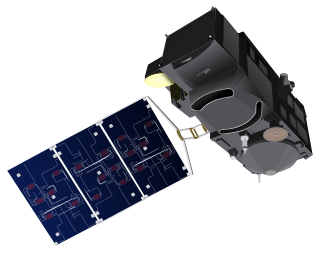
Sentinel-3 is an Earth observation heavy satellite series developed by the European Space Agency as part of the Copernicus Programme. As of 2024, it consists of 2 satellites: Sentinel-3A and Sentinel-3B. After initial commissioning, each satellite was handed over to EUMETSAT for the routine operations phase of the mission. Two recurrent satellites, Sentinel-3C and Sentinel-3D, will follow in approximately 2025 and 2028 respectively to ensure continuity of the Sentinel-3 mission.
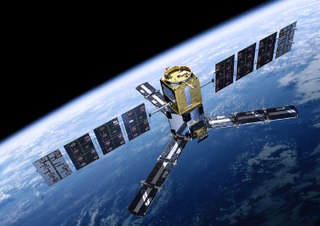
Soil Moisture and Ocean Salinity (SMOS) is a satellite which forms part of ESA's Living Planet Programme. It is intended to provide new insights into Earth's water cycle and climate. In addition, it is intended to provide improved weather forecasting and monitoring of snow and ice accumulation.

The Earth and Mission Science Division is a group of European Space Agency (ESA) staff mission scientists, contractors, research fellows, young graduates, trainees, and administrative staff working within the Climate Action, Sustainability and Science Department of the Directorate of Earth Observation Programmes. The Division is located at ESA's European Space Research and Technology Centre in Noordwijk, South Holland, The Netherlands.

CryoSat-2 is a European Space Agency (ESA) Earth Explorer Mission that launched on April 8, 2010. CryoSat-2 is dedicated to measuring polar sea ice thickness and monitoring changes in ice sheets. Its primary objective is to measure the thinning of Arctic sea ice, but has applications to other regions and scientific purposes, such as Antarctica and oceanography.
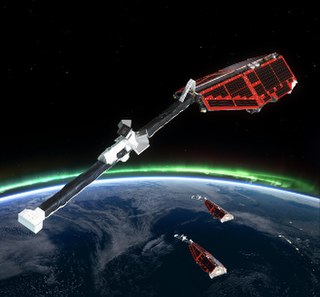
Swarm is a European Space Agency (ESA) mission to study the Earth's magnetic field. High-precision and high-resolution measurements of the strength, direction and variations of the Earth's magnetic field, complemented by precise navigation, accelerometer and electric field measurements, will provide data for modelling the geomagnetic field and its interaction with other physical aspects of the Earth system. The results offer a view of the inside of the Earth from space, enabling the composition and processes of the interior to be studied in detail and increase our knowledge of atmospheric processes and ocean circulation patterns that affect climate and weather.
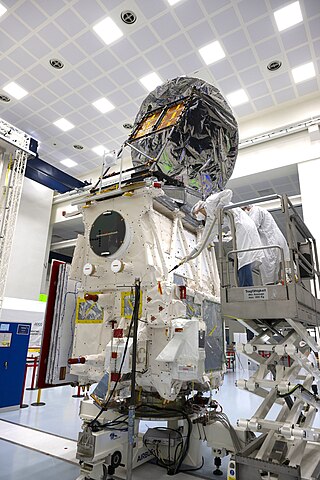
EarthCARE is a joint European/Japanese satellite, the sixth of ESA's Earth Explorer Programme. The main goal of the mission is the observation and characterization of clouds and aerosols as well as measuring the reflected solar radiation and the infrared radiation emitted from Earth's surface and atmosphere.

CryoSat-1, also known as just CryoSat, was a European Space Agency satellite which was lost in a launch failure in 2005. The satellite was launched as part of the European Space Agency's CryoSat mission, which aims to monitor ice in the high latitudes. The second mission satellite, CryoSat-2, was successfully launched in April 2010.
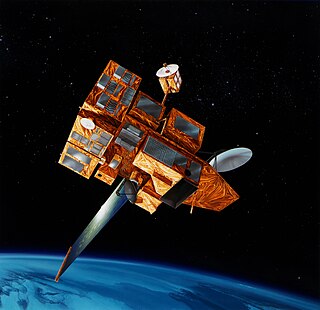
ADEOS II was an Earth observation satellite (EOS) launched by NASDA, with contributions from NASA and CNES, in December 2002. and it was the successor to the 1996 mission ADEOS I. The mission ended in October 2003 after the satellite's solar panels failed.

ADEOS I was an Earth observation satellite launched by NASDA in 1996. The mission's Japanese name, Midori means "green". The mission ended in July 1997 after the satellite sustained structural damage to the solar panel. Its successor, ADEOS II, was launched in 2002. Like the first mission, it ended after less than a year, also following solar panel malfunctions.
ICESat-2, part of NASA's Earth Observing System, is a satellite mission for measuring ice sheet elevation and sea ice thickness, as well as land topography, vegetation characteristics, and clouds. ICESat-2, a follow-on to the ICESat mission, was launched on 15 September 2018 onboard Delta II as the final flight from Vandenberg Air Force Base in California, into a near-circular, near-polar orbit with an altitude of approximately 496 km (308 mi). It was designed to operate for three years and carry enough propellant for seven years. The satellite orbits Earth at a speed of 6.9 kilometers per second (4.3 mi/s).
Biomass is an Earth observing satellite planned for launch by the European Space Agency (ESA) in 2024 on a Vega launch vehicle.

FORUM is an Earth observing satellite that is scheduled to launch in 2027.
References
- ↑ ESA's Living Planet Programme European Space Agency
- ↑ GOCE site, ESA , retrieved 30 January 2016
- ↑ "ESA's water mission SMOS". ESA. 6 November 2013. Archived from the original on 5 January 2016. Retrieved 30 January 2016.
- ↑ Drinkwater, Mark; Kerr, Yann; Font, Jordi; Berger, Michael (February 2009). "Exploring the Water Cycle of the 'Blue Planet': The Soil Moisture and Ocean Salinity (SMOS) mission" (PDF). ESA Bulletin (137). European Space Agency: 6–15.
- ↑ Amos, Jonathan (2 November 2009). "European water mission lifts off". BBC News . Retrieved 30 January 2016.
- ↑ "Eurockot to launch two ESA Earth observation missions". ESA. 9 April 2010. Retrieved 16 February 2019.
- ↑ "Esa's satellite Swarm launch to map Earth's magnetism". BBC News. 22 November 2013.
- ↑ "Aeolus – ESA Future Missions". ESA . Retrieved 19 September 2017.
- ↑ de Selding, Peter B. (22 May 2015). "Cost, Schedule Woes on 2 Lidar Missions Push ESA To Change Contract Procedures". SpaceNews . Retrieved 3 October 2015.
- ↑ "ESA signs EUR 263m earth monitoring satellite contract". Environment Expert. 28 May 2008. Retrieved 30 January 2016.
- ↑ "EarthCARE – Earth Online – ESA". ESA . Retrieved 16 January 2019.
- ↑ "Gearing up for EarthCARE". ESA. 27 October 2023. Retrieved 28 October 2023.
- ↑ "Biomass". ESA. 3 May 2019. Retrieved 27 May 2019.
- ↑ "Biomass – ESA Future Missions". ESA . Retrieved 19 September 2017.
- ↑ Amos, Jonathan (8 May 2013). "Esa approves Biomass satellite to monitor Earth's forests". BBC News . Retrieved 8 May 2013.
- ↑ "Bye-Bye Biomass: forest monitoring satellite departs for final testing before launch". Airbus . 2 November 2022. Retrieved 3 November 2022.
- ↑ de Selding, Peter B. (25 September 2015). "Panel Endorses Vegetation Fluorescence Mapper for ESA's Earth Explorer Program". SpaceNews . Retrieved 3 October 2015.
- ↑ "ALTIUS - ESA's ozone mission". ESA. Retrieved 4 May 2024.
- ↑ "Arianespace to launch with Vega C FLEX & ALTIUS, two ESA programmes at the service of environment". Arianespace (Press release). 11 January 2022. Retrieved 11 January 2022.
- ↑ "Contract secures design for ESA's FORUM satellite". ESA . 28 June 2022. Retrieved 28 June 2022.
- ↑ Status of the Current and Future ESA Earth Observation Missions and Programmes. CGMS-49. ESA . 14 May 2021. pp. 33–37. Retrieved 27 August 2021– via the Internet Archive.
- 1 2 3 "ESA moves forward with Harmony". ESA. 23 February 2021. Retrieved 11 June 2021.
- ↑ "ESA selects Harmony as tenth Earth Explorer mission". ESA . 22 September 2022. Retrieved 22 September 2022.
- ↑ "Calling for ideas for next Earth Explorer". ESA. 25 May 2020. Retrieved 25 May 2020.
- ↑ "Four mission ideas to compete for Earth Explorer 11". ESA. 10 June 2021. Retrieved 11 June 2021.
- ↑ "Cairt and Wivern Earth Explorer candidates go forward". ESA. 21 November 2023. Retrieved 22 November 2023.
- ↑ "CoReH2O – Report for Mission Selection – An Earth Explorer to observe snow and ice". ESA. 1 May 2012. Retrieved 19 September 2017.
- ↑ "PREMIER – Report for Mission Selection – An Earth Explorer to observe atmospheric composition". ESA. 1 May 2012. Retrieved 19 September 2017.
- ↑ "Reports on Earth Explorer Candidates CarbonSat and FLEX Now Available". ESA. 30 June 2015. Retrieved 19 September 2017.
- ↑ "Two new Earth Explorer concepts to understand our rapidly changing world". ESA. 15 November 2017. Retrieved 16 February 2019.
- ↑ "Save the date: Earth Explorer 9 User Consultation Meeting". ESA. 30 January 2019. Retrieved 16 February 2019.
- 1 2 "Three Earth Explorer ideas selected". ESA. 21 September 2018. Retrieved 16 February 2019.
- ↑ "ESA selects for new Earth Explorer mission ideas". ESA. 17 April 2024. Retrieved 16 May 2024.